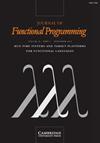编程语言语义:就像1、2、3一样简单
IF 1.1
3区 计算机科学
Q4 COMPUTER SCIENCE, SOFTWARE ENGINEERING
引用次数: 0
摘要
摘要程序设计语言语义是理论计算机科学中的一个重要课题,但对初学者来说往往是一个挑战。本文提供了该主题的教程介绍,其中使用整数和加法语言作为最小设置,以简单的方式表示一系列语义概念。在这种情况下,就像1、2、3一样简单。本文章由计算机程序翻译,如有差异,请以英文原文为准。
Programming language semantics: It’s easy as 1,2,3
Abstract Programming language semantics is an important topic in theoretical computer science, but one that beginners often find challenging. This article provides a tutorial introduction to the subject, in which the language of integers and addition is used as a minimal setting in which to present a range of semantic concepts in simple manner. In this setting, it is easy as 1,2,3.
求助全文
通过发布文献求助,成功后即可免费获取论文全文。
去求助
来源期刊

Journal of Functional Programming
工程技术-计算机:软件工程
CiteScore
1.70
自引率
0.00%
发文量
9
审稿时长
>12 weeks
期刊介绍:
Journal of Functional Programming is the only journal devoted solely to the design, implementation, and application of functional programming languages, spanning the range from mathematical theory to industrial practice. Topics covered include functional languages and extensions, implementation techniques, reasoning and proof, program transformation and synthesis, type systems, type theory, language-based security, memory management, parallelism and applications. The journal is of interest to computer scientists, software engineers, programming language researchers and mathematicians interested in the logical foundations of programming.
 求助内容:
求助内容: 应助结果提醒方式:
应助结果提醒方式:


